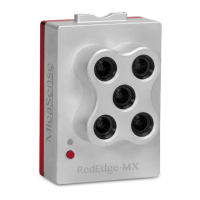
Do you have a question about the MicaSense RedEdge-MX and is the answer not in the manual?
| Brand | MicaSense |
|---|---|
| Model | RedEdge-MX |
| Category | Digital Camera |
| Language | English |
Instructions on how to obtain and install the latest sensor firmware version.
Reference to the official packing list for a comprehensive inventory of kit contents.
Description of the multispectral imaging features and performance characteristics.
Detailed spectral characteristics, including center wavelengths and bandwidths for each sensor band.
Specific spectral data for RedEdge-MX cameras with serial numbers RX02 or higher.
A mapping that associates numerical imager identifiers with specific spectral bands.
Specific spectral data for RedEdge-MX cameras with serial number RX01.
Table detailing the numerical designation assigned to each spectral band.
Specifications for the M3 screw holes and recommended mounting practices.
Table listing the length, width, height, and total mass of the camera and DLS 2.
Advice on positioning the sensor for an unobstructed view of the target area.
Recommendation to implement vibration isolation for maintaining image quality.
Guidelines for sensor orientation, landing protection, and lens care.
Configuration using DLS 2 GPS for automatic capture based on forward overlap.
Using the Flight Calculator to set overlap percentage based on altitude and GSD.
Configuring the camera to trigger via HTTP API commands from an onboard computer.
Integration with PixHawk flight controllers using the MAVLink serial API.
Using external aircraft GPS data via API for sensor positioning and attitude.
How to establish an HTTP connection using Ethernet or Wi-Fi adapters.
Establishing a serial connection for MAVLink communication.
Overview of the RedEdge-MX camera's connectors for peripherals and aircraft integration.
Pinout and specifications for the external power and trigger connector.
Details on nominal voltage, input range, and average power consumption.
Ensuring the power supply meets peak wattage and voltage protection requirements.
Information on using rising-edge, falling-edge, and PWM signals for triggering.
Specifications for trigger signal voltage levels and expected PWM timing.
Pinout and specifications for the serial and Ethernet data communication connector.
Required voltage range, standby, and average/peak power draw.
Options for powering the sensor, including aircraft batteries and external packs.
Verification that the power source meets specified voltage and wattage.
List of compatible Edimax Wi-Fi adapters for wireless connectivity.
How the storage device's speed influences the maximum capture rate.
Adjusting flight parameters to match the capture rate for optimal data acquisition.
Introduction to Overlap, Timer, and External Trigger capture modes.
Detailed explanation of the recommended overlap capture mode for consistent coverage.
How timer mode captures images at set intervals and potential issues.
Enabling external triggers for precise capture control.
Explanation of the 'Disabled' mode for disabling automatic capture functions.
Information on using rising-edge, falling-edge, and PWM trigger signals.
Methods for accessing the API and the JSON data format used.
Default IP addresses and HTTP requests for capturing images.
Links to additional resources and examples for the HTTP API.
How the DLS 2 measures ambient light and sun angle for image correction.
The DLS 2's role in providing GPS data or utilizing external GPS sources.
General recommendations for installing the DLS 2 for optimal performance.
Table of DLS 2 dimensions and specifications for its mounting holes.
Details on the JST-GH connector, trigger button, and status indicator.
Mention of the RF connector present on older DLS 2 models.
Specific installation advice for fixed-wing aircraft to prevent shadowing and reflections.
Specific installation advice for multirotor aircraft regarding height and obstructions.
Avoiding potential interference from paint or other aircraft components.